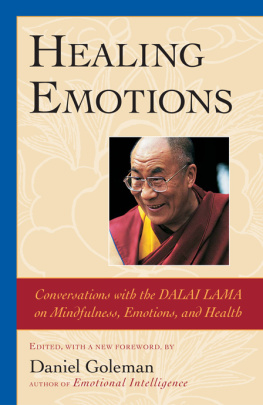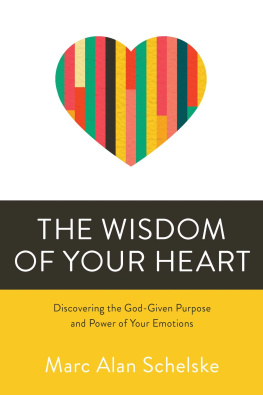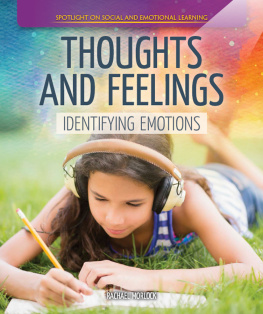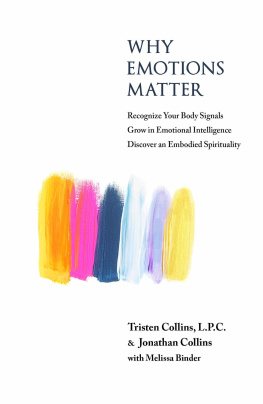
aum
Gajananam bhootganadhisevitam
kapitthya jamboo phalasaara bhakshakam
Umasutam shokvinashkarakam
namami Vighneshwar padpankajam
aum
Elephant-faced, worshipped by all existing beings,
tasting the elephant apple (kaith) and jamun fruit (jambolana),
the son of Uma, destroyer of grief,
I bow to the lotus feet of Ganesha, who is Lord of all.

Acknowledgments
I owe all credit for this book to Sri Harish Johari, who gave the Rasa Siddhanta lecture series that forms the principal basis of this book. All credit goes to him not only because the content is thus really his, but also because I could not have written it without his contribution to my personal development as my teacher since 1983.
As Harish Johari left his body in August 1999 without having written a book on the Rasas, the essences of our emotions, he left me with a great challenge and opportunity. The writing of this book has offered me more in terms of personal growth than the material could ever have given me in any other way. I can only feel very grateful to him.
The Rasas lectures by Harish Johari took place in 1997 in Belgium and were spread out over a period of nine days, for a total of about twenty hours of actual lectures. In between, the small group of students from Belgium and the Netherlands would cook and paint and talk and more, working with the teachings of Harish Johari in a most unique way. And of course, there was no escape from confronting our emotions during that time. This was especially true because Harish Johari, as a real elder brother or Dada, was tickling and teasing us to reveal them and face them. All the while he remained the teacher of many ancient ways, which each student could choose from according to his or her desire and temperament.
I also thank Marian Duys for freely offering her house as the wonderful home where Harish Joharis lectures in Belgium took place, that year and many years before that. While having to act out the role of the hostess to all those visitors, she still found the time to dutifully record every minute of the lectures on tape. My own notes represented only a fraction of the richness of the teaching, so I could have done nothing without her.
I thank the Johari family that allowed me to convert the content of the tapes into a book and to interpret this teaching in my own way. I hope that they still find enough of the original spirit within, in spite of my attempt to also look at the Rasas from a Western point of view. I thank Christine Grnwald for typing out the majority of the lecture tapes. I thank Pieter Weltevrede for creating the great cover image of the Rasas and the image of Ganesha for the frontispiece. I thank those at the publisher Destiny Books for being a constant source of good advice and enthusiasm from the very moment they knew about this project. And I thank the following friends and family for reading through the draft version of this book and providing me with so many interesting comments: Andr Marchand, Chris Marchand, Christine Grnwald, Dominique Van Gerven, Geva Weltevrede, Heidi Rauhut, James Daley, Joe Baxter, John Marchand, Mme. Champagne, Mohit Johri, Monique Marchand, Narmada Devi, Nelleke Sparling, Pieter Weltevrede, Rudy Kuhn, and Wil Geraets. Special thanks also are due for the moral support by Christina Rich Devi.
I thank the Indian people of so many generations for passing on this ancient knowledge, up to the point where my teacher learned it from his parents and his teachers. One does not often think about Indian people as being stubborn, but they are very stubborn at preserving good things.
Of course, I thank everybody that contributed to my life and provided me with the practical experience necessary to understand the play of Rasas and to train my emotional control with Rasa Sadhana, among which of course my parents, family, and son are of foremost importance, along with some of my dear friends and a few of my dear enemies.
Lastbut by far the most worthy of gratitudeis the divine Mother on whose body we are all allowed to enjoy this game of Rasas. In these times, in which the imagination is rather limited when it comes to being grateful, I simply thank life.
Note on the Use of Sanskrit Terms
Converting the Sanskrit language to English is difficult because its alphabet has many more characters. It is particularly difficult to convert the Sanskrit characters that combine vowels and consonants to English without creating spellings that appear strange to some Indian readers. For example, the word Rasa is actually written Ras in Sanskrit, and a short sounding final a is implied. We have included such vowels to come as close to the correct pronunciation as possible, but we would like to apologize to our readers who are Indian-language speakers for the factual incorrectness of this practice.

Introduction
Rasas are the essences of our emotions that exist in both body and mind. The Indian tradition recognizes nine Rasas as representing our most important and basic emotions: Love, Joy, Wonder, Courage, Calmness, Anger, Sadness, Fear, and Disgust. Some are desirable: the cream of life and the very purpose of creation. Others are unpleasant and most often not desirable.
Rasa Sadhana is the Yoga of the Nine Emotions, increasing understanding and exercising control over various flavors of happiness. For example, by temporarily promising ourselves not to be angry in thought, word, and deed, we may come to a better understanding of the Anger Rasa and master it to such extent that we become really free to express Anger or not. Similar vows may be adopted for a lifetime and can provide us with very special powers. Others may be hard to maintain even for one day, but will provide valuable insight and control just the same. Such Rasa fasts are of great help in learning to dissolve unpleasant emotions without suppressing them.
Every imaginable desire ultimately aims at some happy feeling that we expect to enjoy when fulfilling that desire. Rasa Sadhana allows us to pursue happiness more directly and durably. Rasa Yoga is especially useful to the householder who tries to live a spiritual life in modern society. It does not ask us to withdraw from the world, nor does it consume time. It does require that we remain emotionally and spiritually disciplined while participating in the lives of others, twenty-four hours a day. It can be smoothly integrated within other yoga paths and is easily taught by advanced yoga teachers.
of this book provides an overview of Rasa Sadhana and its relationship to both Indian and Western science. According to Indian philosophy and the medical science of Ayurveda, our moods and emotions are continuously affected by the play of elements, senses, food, and vital energy in our body. Modern Western science also fully supports the body-mind link that influences our emotions. With the continuing discovery of so-called neurotransmitters and related biochemicals, the complexity of the biochemical soup that tickles our thoughts and emotions seems to increase by the day. Still, mind governs body and not vice versa, unless we allow it. Indian philosophy further offers a clear insight into the interactions between the Rasas and our mind, intellect, ego, and self.
An in-depth study of each of the nine Rasas is the main subject of of this book. Each Rasa has basic expressions found in both ancient and modern times. They correspond to particular psychological and biochemical environments. Some sub-Rasas exist and each Rasa has clear relationships to other Rasas, allowing us to strengthen or weaken one Rasa through another. In addition to describing these attributes and relationships, Part 2 introduces practical as well as philosophical ways to gain control over each Rasa, specifically in the form of guidelines for the corresponding Rasa Sadhana or emotional fasting exercise.
Next page












